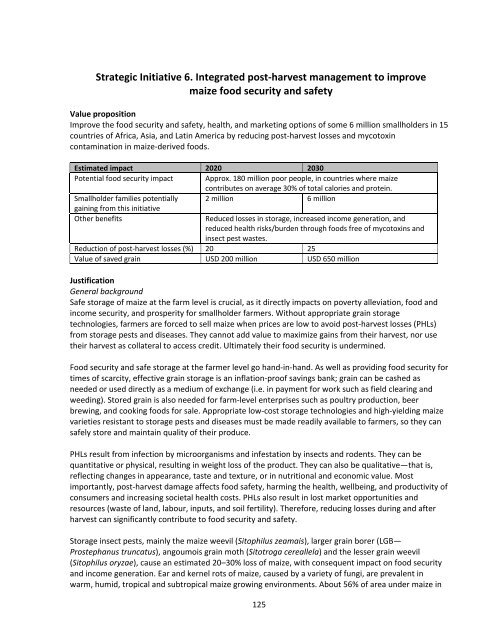Download - Maize
Download - Maize
Download - Maize
You also want an ePaper? Increase the reach of your titles
YUMPU automatically turns print PDFs into web optimized ePapers that Google loves.
Strategic Initiative 6. Integrated post‐harvest management to improve<br />
maize food security and safety<br />
Value proposition<br />
Improve the food security and safety, health, and marketing options of some 6 million smallholders in 15<br />
countries of Africa, Asia, and Latin America by reducing post‐harvest losses and mycotoxin<br />
contamination in maize‐derived foods.<br />
Estimated impact 2020 2030<br />
Potential food security impact Approx. 180 million poor people, in countries where maize<br />
contributes on average 30% of total calories and protein.<br />
Smallholder families potentially 2 million 6 million<br />
gaining from this initiative<br />
Other benefits<br />
Reduced losses in storage, increased income generation, and<br />
reduced health risks/burden through foods free of mycotoxins and<br />
insect pest wastes.<br />
Reduction of post‐harvest losses (%) 20 25<br />
Value of saved grain USD 200 million USD 650 million<br />
Justification<br />
General background<br />
Safe storage of maize at the farm level is crucial, as it directly impacts on poverty alleviation, food and<br />
income security, and prosperity for smallholder farmers. Without appropriate grain storage<br />
technologies, farmers are forced to sell maize when prices are low to avoid post‐harvest losses (PHLs)<br />
from storage pests and diseases. They cannot add value to maximize gains from their harvest, nor use<br />
their harvest as collateral to access credit. Ultimately their food security is undermined.<br />
Food security and safe storage at the farmer level go hand‐in‐hand. As well as providing food security for<br />
times of scarcity, effective grain storage is an inflation‐proof savings bank; grain can be cashed as<br />
needed or used directly as a medium of exchange (i.e. in payment for work such as field clearing and<br />
weeding). Stored grain is also needed for farm‐level enterprises such as poultry production, beer<br />
brewing, and cooking foods for sale. Appropriate low‐cost storage technologies and high‐yielding maize<br />
varieties resistant to storage pests and diseases must be made readily available to farmers, so they can<br />
safely store and maintain quality of their produce.<br />
PHLs result from infection by microorganisms and infestation by insects and rodents. They can be<br />
quantitative or physical, resulting in weight loss of the product. They can also be qualitative—that is,<br />
reflecting changes in appearance, taste and texture, or in nutritional and economic value. Most<br />
importantly, post‐harvest damage affects food safety, harming the health, wellbeing, and productivity of<br />
consumers and increasing societal health costs. PHLs also result in lost market opportunities and<br />
resources (waste of land, labour, inputs, and soil fertility). Therefore, reducing losses during and after<br />
harvest can significantly contribute to food security and safety.<br />
Storage insect pests, mainly the maize weevil (Sitophilus zeamais), larger grain borer (LGB—<br />
Prostephanus truncatus), angoumois grain moth (Sitotroga cereallela) and the lesser grain weevil<br />
(Sitophilus oryzae), cause an estimated 20–30% loss of maize, with consequent impact on food security<br />
and income generation. Ear and kernel rots of maize, caused by a variety of fungi, are prevalent in<br />
warm, humid, tropical and subtropical maize growing environments. About 56% of area under maize in<br />
125

















